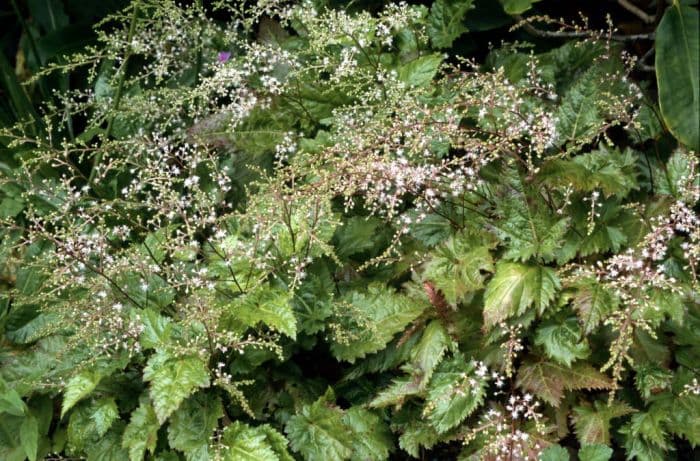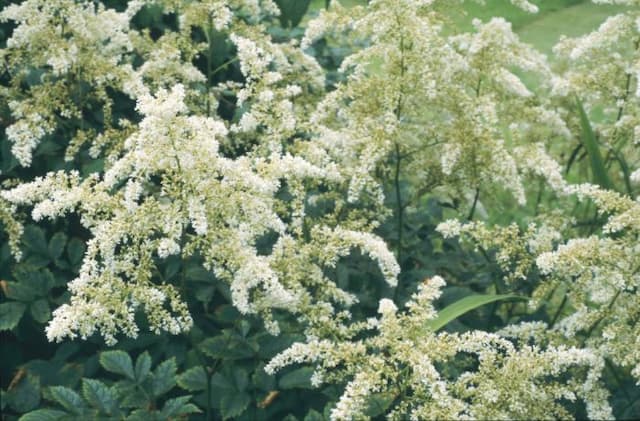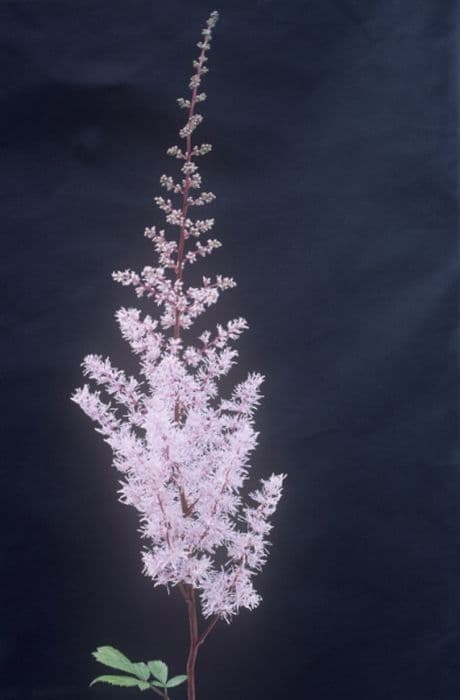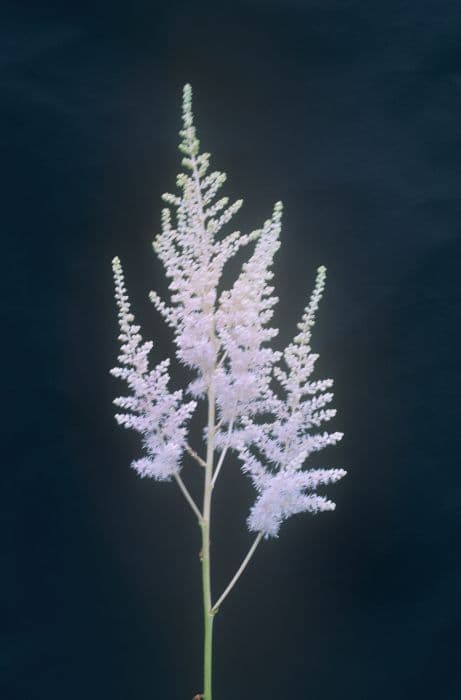Star Astilbe Astilbe simplicifolia

ABOUT
Astilbe simplicifolia, commonly known as simple-leafed astilbe, is a perennial garden plant valued for its attractive foliage and feathery flower plumes. Its leaves are often coarsely textured and can range from a deep, rich green to bronze, providing a lovely contrast in the garden. The foliage tends to be matte rather than glossy, contributing to the plant's lush, natural appearance. The simple-leafed astilbe produces distinctive plume-like flowers that emerge above the foliage on strong, slender stems. These blooms are composed of dense, fluffy spikes covered in tiny flowers that can appear in a variety of colors such as white, pink, lavender, or red. The flowers are known for their delicate look and are often used in floral arrangements. In the garden, they add a light, airy touch and are particularly striking when swaying gently in the breeze. The combination of the simple leaf astilbe's elegant flowers and handsomely textured foliage offers visual interest throughout the growing season, providing both color and texture to shaded garden areas. This plant is a popular choice for woodland gardens, borders, or as a ground cover, creating a lush tapestry of foliage, complemented by the soft, feathery spires of the flowers during the blooming season.
About this plant
 Names
NamesFamily
Saxifragaceae.
Synonyms
Star Astilbe, Narrow-Leaf Astilbe, East Asia False Goat's Beard, Simplicifolia Astilbe.
Common names
Astilbe simplicifolia H.Boissieu, Astilbe simplicifolia var. simplicifolia.
 Toxicity
ToxicityTo humans
Astilbe, commonly referred to by this name, is generally considered non-toxic to humans. There are no widely recognized toxic effects associated with ingesting or handling this plant.
To pets
Astilbe is not known to be toxic to pets. It is generally considered safe for dogs, cats, and other animals, and there are no reports of significant toxic reactions from ingestion.
 Characteristics
CharacteristicsLife cycle
Perennials
Foliage type
Deciduous
Color of leaves
Green
Flower color
Pink
Height
1-2 feet (30-60 cm)
Spread
1-2 feet (30-60 cm)
Plant type
Herb
Hardiness zones
4
Native area
Asia
Benefits
 General Benefits
General Benefits- Low maintenance - Astilbe simplicifolia is known for being easy to care for, requiring minimal upkeep once established.
- Shade Tolerance - It thrives in shady areas where many other plants struggle, making it ideal for woodland gardens or shady borders.
- Attractive Foliage - The plant has attractive, deep green foliage that provides a lush backdrop to a garden even when not in bloom.
- Ornamental Flowers - It produces eye-catching plumes of flowers that can add color and vertical interest to a variety of garden settings.
- Long Blooming - The flowering period of Astilbe simplicifolia is relatively long compared to other shade perennials, extending the garden's color display.
- Attracts Wildlife - Its flowers can attract pollinators like bees and butterflies, contributing to the health of the local ecosystem.
- Drought Resistance - Once established, it can tolerate periods of dryness, although it prefers consistently moist soil.
- Deer Resistant - Astilbe simplicifolia is not a favorite of deer, making it a good choice for gardens in areas with deer pressure.
 Medical Properties
Medical PropertiesThis plant is not used for medical purposes.
 Air-purifying Qualities
Air-purifying QualitiesThis plant is not specifically known for air purifying qualities.
 Other Uses
Other Uses- Astilbe simplicifolia, also known as Star Astilbe, can be used in dried flower arrangements as their feathery plumes retain color and shape for extended periods after drying.
- The Star Astilbe's foliage can offer a contrasting texture in pressed flower crafts, contributing a delicate and intricate aspect to the artwork.
- In a shaded garden, Star Astilbe serves as an excellent ground cover due to its dense foliage, which can help prevent soil erosion on slopes and banks.
- Star Astilbe is occasionally used in educational settings for botanical studies due to its distinct flowering pattern and foliage as an example of shade-tolerant perennials.
- Star Astilbe can play a role in sensory gardens, providing a soft textural component that is pleasant to touch, especially for therapeutic garden experiences.
- The plant's dense clumps can be effective as natural borders or edges for pathways, creating a soft, feathery demarcation in the landscape.
- Star Astilbe is sometimes used in water-efficient gardens as it can thrive in damp, shady areas, thereby reducing the need for supplementary watering.
- In fairy or miniature gardens, the small, delicate appearance of Star Astilbe makes it a popular choice to simulate a forest-like environment in a tiny scale.
- When included in a bouquet, Star Astilbe can offer a woodland aesthetic, bringing a sense of lush, natural charm to the arrangement.
- The plant can be used as a natural dye source for fabrics, providing subtle hues that are extracted from its flowers and leaves.
Interesting Facts
 Feng Shui
Feng ShuiThe plant Astilbe is not used in Feng Shui practice.
 Zodiac Sign Compitability
Zodiac Sign CompitabilityThe plant Astilbe is not used in astrology practice.
 Plant Symbolism
Plant Symbolism- Patience: Astilbe takes time to bloom and requires patience to see its beautiful flowers, symbolizing the virtue of waiting and enduring.
- Endurance: Known for its hardiness and ability to withstand tough conditions, Astilbe represents the strength to endure life's challenges.
- I'll Still be Waiting: The name "Astilbe" sounds like "I'll still be," which has given it a connotation of waiting for someone with loyalty and love.
 Water
WaterStarflower requires consistent moisture, so water it deeply once or twice a week, providing about an inch of water each time. It's crucial to keep the soil moist but not waterlogged, as overly wet conditions can lead to root rot. During hot or dry weather, you may need to water more frequently to maintain the ideal moisture level. In total, aim to supply the plant with approximately 0.5 to 1 gallon of water weekly, adjusted for rainfall and temperature conditions. Ensure that the watering is done at the soil level to avoid wetting the foliage, which can cause fungal diseases.
 Light
LightStarflower thrives in partial shade, where it can receive filtered sunlight or morning sun followed by afternoon shade. The plant's ideal spot would be under a canopy of trees or on the north or east side of a building, where it gets protection from the harsh midday sun. While some morning sun is beneficial, prolonged exposure to intense light can scorch the leaves and stress the plant.
 Temperature
TemperatureStarflower prefers a temperate climate and grows best in temperatures between 60 and 75 degrees Fahrenheit. It can tolerate a minimum temperature down to about 20 degrees Fahrenheit but should be protected from harsh winter conditions. During the growing season, the plant enjoys the cooler end of the temperature spectrum and may suffer in extreme heat above 80 degrees Fahrenheit.
 Pruning
PruningPrune Starflower after blooming to maintain its shape and encourage a second flush of flowers. Cut back the spent flower stalks and any dead or damaged foliage to keep the plant looking tidy. Pruning is often done in late summer or early fall, but refrain from excessive pruning as winter approaches to avoid reducing the plant's hardiness.
 Cleaning
CleaningAs needed
 Soil
SoilStarwort, or Astilbe simplicifolia, thrives best in moist, well-draining soil with a high organic matter content; a mix of peat, perlite, and loamy soil is often beneficial. Aim for a soil pH of slightly acidic to neutral, around 6.0 to 7.0, to ensure optimal growth and health.
 Repotting
RepottingStarwort generally doesn't require frequent repotting and can be done every 2-3 years, or when it becomes root-bound. To minimize stress, repot in spring before the onset of new growth.
 Humidity & Misting
Humidity & MistingStarwort prefers a high humidity environment, ideally above 60%. If the air is too dry, especially indoors, provide additional humidity through misting or a humidity tray.
 Suitable locations
Suitable locationsIndoor
Ensure high humidity, indirect light, and keep soil consistently moist.
Outdoor
Plant in partial shade and moist, rich soil; mulch to retain moisture.
Hardiness zone
4-8 USDA
 Life cycle
Life cycleThe life of Astilbe simplicifolia, commonly known as simple-leaf astilbe, begins with seed germination, which requires a period of cold stratification to break dormancy. After germination, the seedlings grow into juvenile plants, developing a characteristic clump of fern-like foliage and a robust root system. As the plant matures, it enters the vegetative stage, where it focuses on leaf growth and root expansion. Following this, the reproductive stage commences, typically in the summer, when the plant produces feathery plumes of flowers that can be white or pale pink, attracting pollinators to the garden. After pollination, seeds are produced, leading to the senescence phase where the plant's aerial parts die back in autumn, with the roots remaining dormant through the winter. The cycle begins anew when warmer spring temperatures trigger the plant to break dormancy, sending up new shoots for another growing season.
 Propogation
PropogationPropogation time
Early spring
Propogation: Astilbe simplicifolia, commonly known as Star Astilbe, is usually propagated by division, which is both the easiest and most popular method. The best time for dividing Star Astilbe rhizomes is in early spring or late fall when the plant is dormant. To propagate Star Astilbe by division, carefully dig up the clump of the plant, making sure to keep a good amount of soil around the roots to avoid shock. Using a sharp knife or spade, you should divide the clump into smaller sections, ensuring that each division has at least 2 to 3 good buds or growing points. Replant the divisions at the same soil depth they were growing previously and water them in well, applying about an inch (2.54 cm) of water. This division method not only helps to propagate new plants but also to rejuvenate old clumps that may have become too dense, helping to maintain the health and vitality of the Star Astilbe in your garden.









